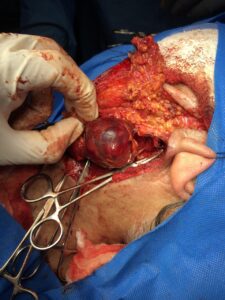Retrothyroidal intramuscular haemangioma (Feb.2019)
Case presentation
A 42 year old female patient presented with chronic cholecystitis and advised for laparoscopic cholecystectomy. The operation done by 3 ports and critical view of safety achieved. Cystic artery and cystic duct clipped separately and divided. During dissection of gallbladder from hepatic bed small subvesical duct inadvertently partially opened and few drops of bile came out so that was a duct of Lushka and was managed by double clipping by using titanium clips. The operation completed after insertion of tube drain. The postoperative course was smooth and postoperative drain was nil. The patient discharged in 2nd postoperative day. She was followed for 6 weeks without significant symptoms.
Review of literature-1
Surgical importance of Duct of Luschka on bile duct leak: empirical review of literature
- Cortes∗’Correspondence information about the author N. Cortes , J.C. Sabogal
Abstract
Background: Traditionally the Luschka’s canal has been mentioned as an anatomical variant of the bile duct. The clinical manifestation of Luschka ducts has become evident on laparoscopic cholecystectomy when bile leakage appears from the hepatic bed without injury of a main bile duct. However, there is scarce literature on this subject and there is no uniform definition that allows an adequate understanding and its surgical relevance.
Methods: A narrative literature review is done. Thirteen articles were found in relation to the concept of what has traditionally been called Duct of Luschka and its relation with the bile duct injury. In addition, understanding and comprehension of the ducts on laparoscopic cholecystectomy.
Results: After reviewing papers selected, Duct of Luschka was described for the first time by the German Hubert von Luschka (1863). The Luschka ducts (supravesicular or subvesical ducts) are small bile ducts (1–2 mm in diameter) in the hepatic bed, which communicate with the main bile duct, but do not drain into the gallbladder. They can present in a significant number of patients. Preoperative and intraoperative diagnosis is not easy. Even though there is no enough information, review highlighted importance of its recognition on potential biliary lesions or biliary leak.
Conclusion: The best compression of the bile duct subvesical or Luschka is relevant on laparoscopic cholecystectomy. Surgeons should keep in mind its importance on potential biliary lesions or biliary leaks.
Review of literature-2
Intraoperative Treatment of Duct of Luschka during Laparoscopic Cholecystectomy: A Case Report and Revision of Literature
Luigi Masoni,1 Leandro Landi,2 and Riccardo Maglio3
1Universitary Researcher Department General Surgery Sapienza University of Rome, Italy
2University of Naples Vanvitelli, Italy
Department of General Surgery, Hospital Veris Delli Ponti, Scorrano, Italy
Abstract
Background. Bile leakage still remains a serious complication during cholecystectomies. In limited cases, this complication may occur from injury of the so-called ducts of Luschka. These rare ducts are usually discovered intraoperatively, and their presence poses the risk of bile injury and clinically significant bile leak.Presentation Case. We present a unique case of a 59-year-old male patient with acute cholecystitis. After removal of the gallbladder, thorough inspection of the hepatic bed was made and a little bile leak was identified from a duct of Luschka 1 cm away from the gallbladder hilum. We report on the use of endoscopic QuickClip Pro® clips (Olympus Medical Systems Corp., Tokyo, Japan) to avoid further more invasive treatment.
Discussion. Endoscopic retrograde cholangiopancreatography with sphincterotomy played a crucial role for diagnosis and treatment of bile leaks with success rate near 94%. Many authors have argued the role of relaparoscopy, Diagnosis may be intraoperatively but this option does not seem to occur very often; in fact, there is a lack of data in literature.
Conclusion. This is the first case report of bile leak from duct of Luschka treated during the cholecystectomies with endoscopic clip..



